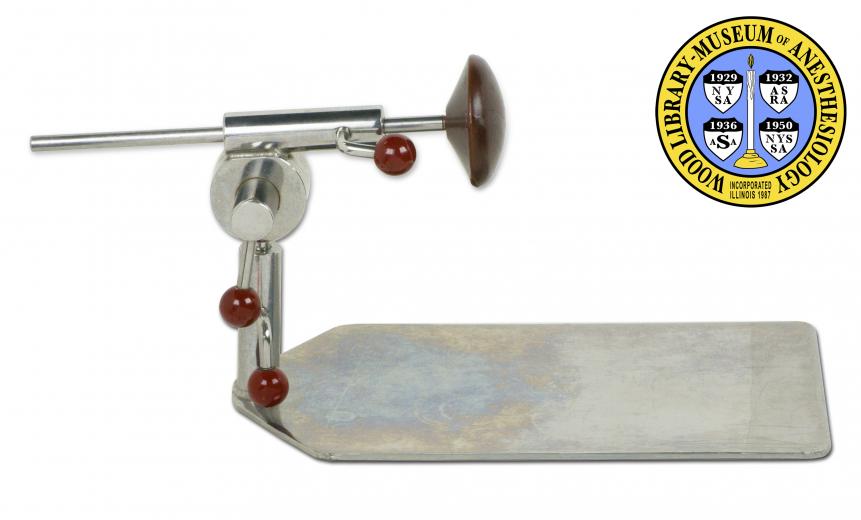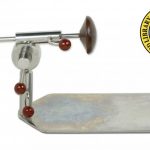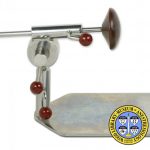C-M Uterine Displacer
When a pregnant woman lies flat on her back (the supine position), her uterus and the fetus press on her inferior vena cava (a large vein that transports de-oxygenated blood from the body to the heart and lungs). Pressure on the vena cava can impair blood circulation to the mother and placenta. A woman can take pressure off of the vena cava by lying on her side, but many surgical procedures, including caesarean sections, require the mother to be in a supine position. Dr. Miguel A. Colon-Morales designed the Uterine Displacement Device to reduce pressure on the vena cava while the mother was supine. The large metal baseplate was placed on the mother’s right side under the mattress. Next, the bar with the rounded pressure pad was adjusted to reposition the uterus slightly to the left, lessening pressure on the vena cava. Before Dr. Colon-Morales created this device, also called “The ‘C-M’ Uterine Displacer” and “The Third Hand,” a member of the surgical team would perform this function. Dr. Colon-Morales argued that this practice was an inefficient use of manpower.
Catalog Record: C-M Uterine Displacer
Access Key: aijt
Accession No.: 1992-05-13-1 B
Title: [Colon-Morales uterine displacement device / designed by Miguel A. Colon-Morales.]
Author: Colon-Morales, Miguel A.
Title variation: Alt Title
Title: Colon-Morales’s uterine displacement device.
Title variation: Alt Title
Title: C-M uterine displacer.
Title variation: Alt Title
Title: Left uterine displacement device.
Publisher: [S.l. : s.n., ca. 1970.]
Physical Description: 1 surgical utility instrument : aluminum, stainless steel(?), leather?,
plastic ; 22 x 36 x 20.5 cm.
Subject: Anesthesia, Obstetrical.
Subject: Hypotension – prevention & control.
Subject: Patient Positioning.
Subject: Pregnancy Complications – prevention & control.
Subject: Obstetric Labor Complications – prevention & control.
Subject: Cesarean Section.
Note Type: General
Notes: Title from the WLM name for the object. In figure 1 of Dr. Colon-Morales’s
article about the device it is referred to as, “left uterine displacement
device” (1970). An ad for the device held in the Colon-Morales Collection
(MMS 36, FF 2/3) uses the name, “C-M Uterine Displacer”.
Note Type: Citation
Notes: Colon-Morales MA. A self-supporting device for continuous left uterine
displacement during cesarean section. Anesth Analg. 1970;49(2):223-224.
Note Type: Citation
Notes: Howard BK, Goodson JH, Mengert WF. Supine hypotensive syndrome in late
pregnancy. Obstet Gynecol. 1953;1(4):371-377.
Note Type: Citation
Notes: McRoberts WA, Jr. Postural shock in pregnancy. Am J Obst & Gynec. 1951;
62(3):627-632.
Note Type: Physical Description
Notes: Uterine displacement device composed of articulated, adjustable, metal bars
attached to a thin rectangular base; A vertical bar is attached to the
stainless steel rectangular base at a 90 degree angle; Adjustable attachments
hold a second bar horizontally; Dark red, spherical, plastic -knobs top
levers that allow the height, angle, and horizontal depth of displacement to
be adjusted independently; A dome shaped, leather[?] covered “plunger”, 7.5
cm. in dia., is attached to the proximal end of the horizontal bar; This
“plunger” is the only part of the displacer that has contact with the
patient; The base on the operating table holds the entire device in place.
Note Type: Reproduction
Notes: Photographed by Mr. William Lyle, 7/27/2010.
Note Type: Acquisition
Notes: Donated to the WLM by Miguel Colon-Morales, M.D., in 1992.
Note Type: Historical
Notes: In the early 1950s practitioners in Texas and Britain described and began
studying what is now commonly referred to as supine hypotensive syndrome
(McRoberts, 1951; Howard, Goodson, Mengert, 1953). When a pregnant woman lays
flat the enlarged uterus presses on the inferior vena cava affecting blood
flow to the mother and placenta. Spinal anesthesia may hasten the effect. The
reduction in circulation can have serious consequences for both mother and
fetus. Displacing the uterus away from the vena cava to alleviate the
pressure is simple: uterine pressure on the vena cava is reduced when the
pregnant woman lays on her side, especially her left side. Dr. Colon-Morales
noted difficulties in achieving effective uterine displacement during surgery
for a cesarean section: methods used tended to interfere with the surgical
procedure or called for inefficient or unrealistic use of manpower
(Colon-Morales, 1970). Dr. Colon-Morales designed the uterine displacement
device to affectively address these difficulties. The “plunger was placed in
the space between the last floating rib and the right iliac crest” on the
patient’s right side (Colon-Morales, 1970). The plunger’s bar was then
adjusted and moved to the left until the uterus was sufficiently displaced.
Note Type: Publication
Notes: Bonica JJ. Obstetric Analgesia and Anesthesia. Amsterdam: World Federation of
Societies of Anesthesiologists;1980:165-196.



